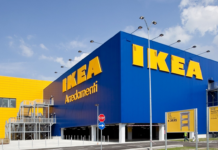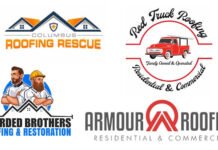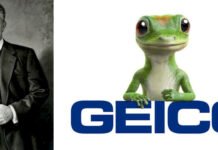The Nerf logo design has always been about the brand name “Nerf” in huge uppercase letters. The letters were drawn in yellow for most of the brand’s history. While the logo has gone through no fewer than five alterations, the basic styles are clear to see.
While the older “childish” versions portray a playful, creative typeface with “dancing” letters, the newer “sporty” designs focus on italics and more standard shapes.
Nerf is a world-famous brand of toy guns and sports balls. The off-road racing community uses the slang term Nerf to portray the foam stuffing that’s used in off-road racing. Nerf (Non-Expanding Recreational Foam) is wrapped around off-road cars’ support bars to prevent damage to the vehicles.
As of 2021, Nerf was still owned by Hasbro, Inc.
The Nerf Logo Evolution
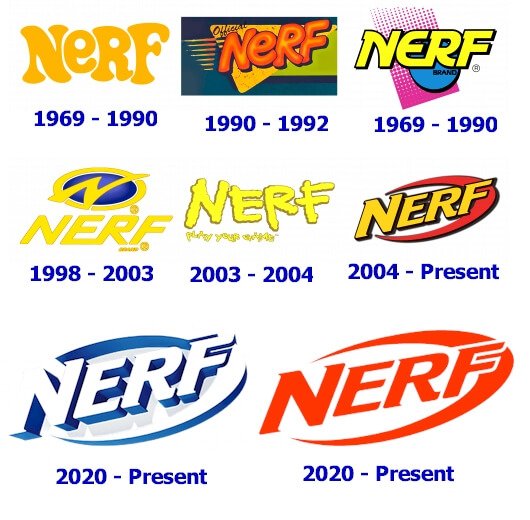
While the Nerf logo has always been text-based, the logo design itself has changed quite a lot—it’s gone through a number of significant changes.
1969 – 1990
From the toy manufacturer’s founding until 1990, the company had a yellow logotype with no extra features. The short “NERF” logotype looked weird due to the stylized typeface where the letters featured a fantasy design.
The Nerf logotype had letters “N,” “R,” and “F” in uppercase combined with “E” in lowercase to make the visual identity even more informal. Wide lines, rounded corners, and strong asymmetry portrayed the playfulness of the brand.
This logo version was introduced in 1969 when Nerf designed a safe-to-use polyurethane ball of foam that couldn’t break anything. The Parker brothers started selling the foam ball the next year, marketing it as suitable for the indoors.
1990 – 1992
The Nerf logo was updated in 1990, losing some of the irregularity and playfulness of the original version. While the letters still seemed like they’d been hand-drawn, it looked as if they’d been more skillfully drawn by an adult hand, and the drawing couldn’t be more different from that of a child.
While yellow remained in the middle of the letters, darker shades and red details were added. For this reason, there was more depth now. Behind the logotype, a combination of green and yellow rectangles appeared against the blue background.
1992 – 1998
The Nerf logotype became even more “mature.” Now, the letters didn’t seem to be handwritten, but they retained their artistic and unique touch. For example, the upper side of letters “F,” “R,” and “N” had creative “serifs,” while the diagonal bars in letters “R” and “N” featured curves instead of straight lines.
A blue circle was seen in the background, which was likely inspired by a foam ball, Nerf’s first product. Behind the ball, a purple shape with numerous white dots and straight angles could be seen.
This logo design looked less warm than the previous one and not at all childish. Only the bright colors still evoked the playful nature of the previous versions.
In addition, this design was quite dynamic thanks to the italicized font and purple shape’s diagonal direction. The blue circle didn’t appear static—perhaps it symbolized a ball that was bouncing from the ground. Also, there was another more basic design, in which there was no purple shape, and the ball was drawn in red.
1998 – 2003
The Nerf logo design of this era started to appear more professional. But it looked more like a sports logo since there wasn’t a “childhood” or “toy” vibe about it.
The font lost the unusual serifs and curves. Rather, it was a standard italicized font. However, the joining of the “E” to the “R” added a special touch. An emblem was featured above the logotype, in which a stylized “N” appeared in front of a blue ellipse with a thick yellow border.
2003 – 2004
The 2003-2004 Nerf logo had the most “childish” feel of all versions. It appeared to have been drawn by a child who was learning to write. Moreover, the lines of the letters suggested that someone had drawn them with their finger using paint.
2004 – 2020
The Nerf logo got back its sporty feel, and a nobler yellow featuring a brownish tint replaced the juvenile light blue. This logo design even featured a red swoosh, accentuating the sporty feel.
There’s an alternative logo version available as well. It looks darker thanks to the blackish background that was added behind the logotype.
2020 – Present
To make its visual identity more refined, Nerf adopted a new logo design featuring a 3D effect. While it resembles the previous design, the surrounding arc and brand name are drawn in silver with a cascade of shades.
The paths are all blue, with a gradient as well. Both the boomerang and letters cast see-through light gray shadows, emphasizing the 3D design even further.
The Nerf Logo Design Elements

Font: The Nerf logo has a bold, oblique font with short triangle-shaped serifs. The font is known as Letraset Crillee, and it was designed by Dick Jones, Vince Whitlock, and Peter O’Donnell between 1987 and 1990.
Color: The Nerf logo has kept its color scheme fairly consistent. From the very first design, yellow or gold has always been the main color, but with different tints. While some versions only had yellow, others featured a more varied color scheme.
The History of Nerf
As a kid, no feeling was more powerful than carrying a Nerf gun in your hand with its barrel pointed at your mate. In the 1990s, a Nerf gun was the equivalent of a Colt Peacemaker inside the belt of a Wild West gunslinger.
With a long, eventful history starting in 1969, Nerf has been supplying children—and lads at sassy technology startups—with toy guns containing foam-rubber ammunition for decades, and they’re still going from strength to strength. Here’s a quick look at its history.
Nerf Origins
Nerf was originally founded by Parker Brothers in 1969, starting with a 100 mm (4-inch) polyurethane foam ball. Minnesota-based games creator, Reyn Guyer, came to Nerf with a safe indoor football game in 1969. After carefully studying it, Parker Brothers decided to do away with everything except the foam ball.
The following year, Nerf introduced the Nerf ball as “the first-ever official indoor ball in the world,” with the term “Nerf” being slang for the foam stuffing used in off-road racing. Marketing catch phrases promised that you could “Throw it indoors without breaking windows or damaging lamps.” Or “You can’t hurt old people or babies.”
The first TV ads for Nerf balls included joint promotions with the Kool-Aid drink cocktail, with Davy Jones, Micky Dolenz, and Michael Nesmith playing with the foam balls on a lounge soundstage. The Nerf ball satisfied a strong consumer demand, and by the end of 1970, over 4 million balls had sold out.
The 4-inch Nerf ball paved the way for a large version known as the “Super Nerf Ball” in 1971. The following year, a basketball game known as “Nerfoop” as well as the Nerf football joined the Nerf family, with the football quickly becoming the company’s most popular ball.
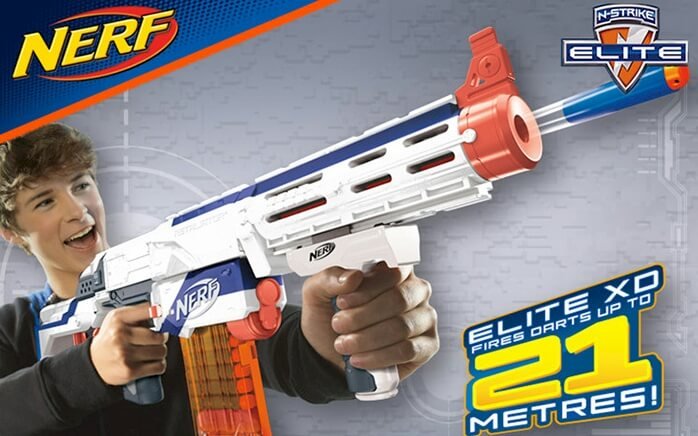
Nerf continued to expand the Nerf range of products until a sister company, Kenner Products, took over the business. The Tonka Corporation acquired Kenner Products in 1987, but the company itself was taken over in 1991 by Hasbro, making Hasbro the Nerf brand owners. Throughout the 1990s to early 2000s, Nerf was under the subsidiaries Larami and OddzOn before Hasbro took total control of it.
Nerf has always looked to expand its product lines throughout its history, giving existing products new looks, with later Nerf product lines including sports balls, foam dart blasters, accessories, and video games.
In early 2013, Hasbro introduced the “Rebelle” line, a girls-only sub-line, with the first products introduced in fall 2013. In November the same year, Nathaniel Marunas’ “The Ultimate Nerf Blaster Book” was published by POW! Books. The book narrates the origins of Nerf and describes every N-Strike, Vortex Blaster, and Dart Tag produced as of when the book was released.
In 2015, Hasbro introduced the Rival range of blasters. The first products introduced were Rival Zeus MXV-1200 and Rival Apollo XV-700. These blasters shoot a new kind of ammunition, called “High Impact Rounds”—little foam balls that achieve a higher velocity compared to foam darts. Aimed at an older audience, the Rival line is suitable for those aged 14 and over.
In 2021, Hasbro introduced the Hyper range of blasters. The first products included the Hyper Mach-100, Hyper Siege-50, and Hyper Rush-40. Hyper rounds have the same design as Rival Rounds, but they’re smaller and created with thermoplastic elastomer, a material that’s more like rubber as opposed to the foam used to make Rival rounds.
Key Nerf Timelines
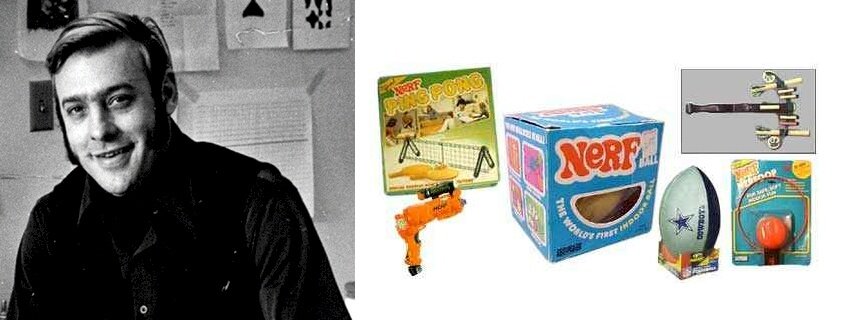
1969: Nerf introduces the Nerf ball. By the end of 1970, over 4 million Nerf balls were sold out.
1972: Nerfoop (a basketball game) and Nerf football are introduced to the Nerf family, launching the Nerf Sports section.
1983: Nerf Baseball is introduced, allowing baseball to be played in the living room for the first time.
1989: The Power Drencher (originally called the Super Soaker) is introduced, revolutionizing the water blasters industry.
Invented by Atlanta aerospace engineer Lonnie Johnson, this blaster, later renamed Super Soaker 50, applied trademarked air pressure technology, enabling the user to fire large volumes of water faster and further than any other comparable product out there.
1991: The Tonka Corporation (including Parker Brothers and Kenner Products) is bought by Hasbro, Inc, making Hasbro the owners of the Nerf brand. Nerf’s first bow and arrow are also introduced.
1992: The first Nerf dart blaster, the Nerf Sharpshooter, is introduced.
2004: The N-Strike fad starts. Nerf N-Strike blaster came equipped with the special Unity Power System featuring three blasters that the user could fire at the same time or take apart and fire individually.
Thanks to the special Unity Power System, tactical rail was introduced to Nerf, enabling the idea of multiple layouts and interchangeable parts for the ultimate playing experience.
2008: The N-Strike line gets a new product named Nerf Vulcan blaster. It’s still one of the largest and best blasters to date.
2011: In September 2011, the Nerf Vortex range of disc throwing blasters was introduced. A whole new blaster experience, the range offered fans the most up-to-date blaster performance and technology.
2012: The innovative new Firevision range gives Nerf Sports an upgrade, allowing players to continue playing well into the night. Using Fire Frames eyewear and reflective Firevision technology, players couldn’t lose sight of the ball even when the lights were off.
2013: Nerf continues to meet the wildest expectations of fans and launches the Centurion blaster, which is the brand’s first blaster to use outsize Mega whistler darts.
2014: Nerf marks its 45th birthday with extended product lines, improved performance and blaster distances, as well as design developments such as the first free-play designed Bash Ball and built-in blaster camera.
2015: Nerf continues to grow to meet customer demand and surpass expectations, launching both the Nerf Rival range for players aged 14 and over and the N-Strike Modulus section, which allows fans to customize their blasters.
2016: Nerf builds its first remote-controlled blaster drone called the N-Strike Elite Terrascout RC. With a camera and live video feature, an 18-dart pin for remote bombardment, as well as ability to work outdoors and indoors, Nerf continues to improve upon its first-class blaster technology.
2017: Nerf improves its Nerf N-Strike range with the Accustrike range. The Accustrike range offers fans the best in blaster innovation, accuracy, and performance with the most precise Nerf dart today.
2019: Nerf launches a series of Fortnite blasters that let fans taste the Battle Royale experience through the adventurous and active fun of Nerf.
2021: The innovative Nerf Hyper system is introduced. It features Nerf Hyper rounds made with innovative material and design for unmatched performance to maximize speed and capacity.
Wrapping Up the History of Nerf
Owned currently by Hasbro, Inc, Nerf is a toy manufacturer that Parker Brothers founded. Most of Nerf’s toys are a range of foam-based weapons, with other products including balls for games such as baseball, basketball, and American football.
The most popular toys by Nerf are its dart guns (commonly known as blasters) that fire ammunition made with “Nerf foam,” which is a partially interwoven polyether form of polyurethane foam.
The Nerf brand makes average annual revenues of approximately $400 million.


